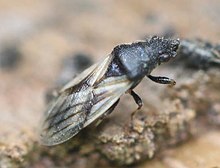Metopoplax ditomoides
| Metopoplax ditomoides | ||||||||||||
|---|---|---|---|---|---|---|---|---|---|---|---|---|

Metopoplax ditomoides |
||||||||||||
| Systematics | ||||||||||||
|
||||||||||||
| Scientific name | ||||||||||||
| Metopoplax ditomoides | ||||||||||||
| ( A. Costa , 1847) |
Metopoplax ditomoides is a bug from the family of Oxycarenidae .
features
The bugs are 3.4 to 4.0 millimeters long. They have a dark front body and contrasting whitish hemielytras . The head, the pronotum and the scutellum are densely dotted and covered with fine white hairs. The front plate ( clypeus ) is widened. The second antenna element is colored yellow-brown except for the ends. The apical ends of the femora and the tibia, with the exception of the basal end and the first phalanx, are also colored yellow-brown.
distribution and habitat
The species is distributed in south-west Europe from the south of England, the Netherlands, France and western Germany to the Iberian Peninsula and Italy. It is also found in western North Africa to Tunisia, and was recently introduced into the United States by humans. Historically, the species is only known from the southwest in Germany. In recent years, however, it has gradually expanded to the north and northeast and now also occurs as far as the Rhineland and the south of Lower Saxony and Saxony-Anhalt. It is rare but can occur locally in large numbers. In Great Britain it was originally only known as a rare stray visitor, but is now considered down-to-earth in parts of the south of England and is common there in some years. Very warm and dry, sparsely overgrown habitats such as fields and roadsides as well as ruderal areas are settled.
Way of life
The animals live on chamomiles ( Matricaria ) and dog chamomiles ( Anthemis ). Mating takes place from May to June on the food plants. There are also observations of mating in August, which suggests a second generation per year if the conditions are favorable. The overwintering takes place as an imago in the litter or under loose bark, often at a greater distance from potential food plants. The bugs fold their antennae under their bodies to protect them.
supporting documents
Individual evidence
- ↑ a b c Wachmann: Wanzen , Vol. 3, p. 146
- ↑ a b Metopoplax ditomoides. British Bugs, accessed June 21, 2014 .
literature
- Ekkehard Wachmann , Albert Melber, Jürgen Deckert: Bugs. Volume 3: Pentatomomorpha I: Aradoidea (bark bugs), Lygaeoidea (ground bugs, etc.), Pyrrhocoroidea (fire bugs) and Coreoidea (edge bugs, etc.). (= The animal world of Germany and the adjacent parts of the sea according to their characteristics and their way of life . 78th part). Goecke & Evers, Keltern 2007, ISBN 978-3-937783-29-1 .
Web links
- Metopoplax ditomoides in Fauna Europaea. Retrieved June 21, 2014
